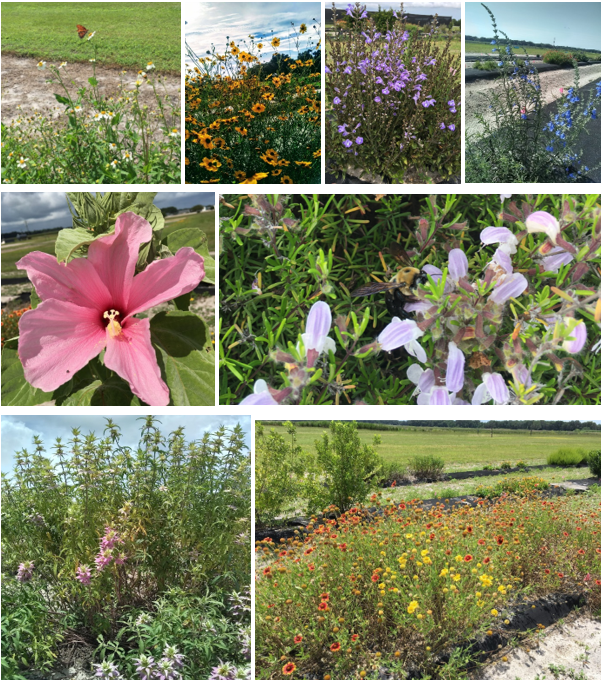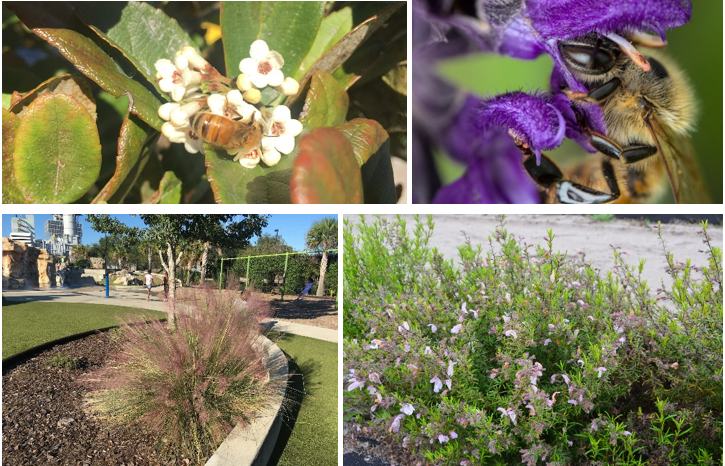This article was written by: Joanna Jaramillo Silva1, Rachel Mallinger2, Xavier Martini3
1 Ph.D. Student, University of Florida, Department of Entomology and Nematology
2 Assistant Professor, University of Florida, Department of Entomology and Nematology
3 Assistant Professor, North Florida Research and Education Center, University of Florida, Department of Entomology and Nematology
Bees are the primary pollinators of plants, essential in natural and crop environments for guaranteeing global food security to the human population. Florida is home of more than 300 species of native wild bees, which rely on pollen and nectar from flowers to survive. However, a global pollinator decline reported for honeybees and wild species (including insects, birds, and bats), is decreasing the worldwide provision of pollination services. Food limitation (pollen and nectar), resulting from decreasing flower diversity and quantity, is one of the multiple causes of pollinator decline. Pollinator-friendly plants are receiving attention from people of various disciplines such as the scientific community, stakeholders, Master Gardeners, and citizen science groups willing to participate in pollinator conservation efforts.
Domestic gardens
Domestic gardens comprise a substantial proportion of land in the urban landscape and are often the most significant component of green space; they play essential roles in conserving plant genetic resources, insects, and other wildlife, and have social and economic value. Gardens behave as islands of usable habitat surrounded by urbanization, and they present varying benefits for pollinators. There is generally a positive relationship between high pollinator abundance, flower diversity, and bloom evenness. Gardens for pollinators propose to solve the pollinator crisis by enlarging greenspaces in urban areas by planting more flowers in urbanized environment and by improving the diversity of floral resources for pollinators.
Pollinator friendly plants
There are different categories of floral traits: qualities that attract pollinators such as floral size and color, and physical characteristics that reward the pollinator (nectar and pollen quantity and quality). Flowers with higher quality and quantity rewards are more attractive to pollinators. Nectar provides the main sugar source for insect pollinators; its energetic value is determined by its sugar concentration. The volume of nectar produced by flowers will directly affected visitation by honeybees and bumblebees, butterflies, and birds. Pollen on the other side, consists of the main source of protein for most pollinators.
RECOMMENDATIONS
1. Provide a Mix of floral shapes and sizes.
There is usually a positive correlation between flower size and nectar volume: long tube flowers usually provide more nectar, whereas open or flat flowers provide more pollen. In addition, flower shapes are also associated with different pollinator types (Fig. 1). Long-tongued insects (Butterflies, and some bees) visit deep corolla tube flowers, while short-tongued pollinators (wasps, flies and some bees) remain on short tube or open corolla flowers.

2. Provide a mix of flower colors
Color patterns influence the flower’s attractiveness and increase the efficiency of pollination by helping insects orient on the flower and guide them to the reward (Fig. 2). Bees prefer white, yellow, or blue-purple flowers. Orange, pink, and red flowers attract other pollinators such as butterflies.

*A recent discovery suggests that Firewheel is not considered native to Florida, but it is widely cultivated. It is probably not native to the rest of the eastern USA as previously thought (ISB: Atlas of Florida Plants (usf.edu), Gaillardia – University of Florida, Institute of Food and Agricultural Sciences (ufl.edu)).
3. Include a pollinator hotel
Add a bee nest box for the native bees that build their nests above ground. Solitary bees and wasps will take up residence in a pollinator hotel after you place it outside.
4. Provide flowers throughout the year.
Pollen and nectar collection varies seasonally for honeybees, while many other solitary bee species collect pollen continuously during adult foraging to feed their larvae. Design the garden to have three or more different plants blooming at any given time during the growing season, which is March through November in northern areas of the state (Fig. 3).

5. Include native plants.
A “Florida native plant” refers to a species occurring within the state boundaries prior to European contact, according to the best available scientific and historical documentation. Florida is home to over 4,867 species of plants; 3,314 species are considered native of which 230 species are endemic.
6. Chose the right plant for each location.
Success depends on using the right plant in the right place, especially by considering plant’s cold hardiness (Fig. 4). Plant selection for landscapers, nurseries, and gardens requires individual site criteria and an evaluation of individual plant performance under different environmental circumstances, such as water, soil, and temperature.
7. Resources
- Access information your hardiness zone: http://planthardiness.ars.usda.gov
- Create a list of recommended natives by county visit Florida Native Plant Society (FNPS), ISB: Atlas of Florida Plants (usf.edu)
- Buy from native nurseries ( Plant Real Florida | Bring Your Landscape to Life with Native Plants)
- Select plants and design your bee garden https://ffl.ifas.ufl.edu/bees/
- ENY2042/IN1255: Attracting Native Bees to Your Florida Landscape (ufl.edu).
- Pollinator Hotels – Gardening Solutions – University of Florida, Institute of Food and Agricultural Sciences (ufl.edu)
- Gardening in the Panhandle LIVE! Program Summary: Pests of Florida Lawns and Landscape Plants - May 28, 2025
- Fun Facts About Ferns - April 30, 2025
- Gardening in the Panhandle LIVE! Program Summary: Freeze Friendly Foliage Plants - April 30, 2025

